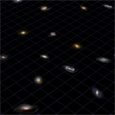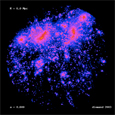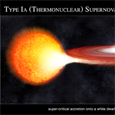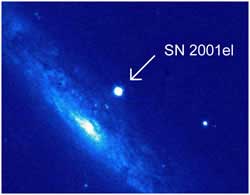In 1998 two teams of astronomers reported that the light from distant Type Ia supernovas that exploded billions of years ago is inexplicably faint. The best explanation for this is that they are more distant than originally thought, which implies that the expansion of the universe is not slowing down, as expected, but accelerating. In the years that followed, this astonishing result has been confirmed by more detailed studies of Type Ia supernovas, as well as independent evidence from clusters of galaxies, the large scale distribution of galaxies, and the cosmic microwave background radiation.
The favored explanation for the cosmic acceleration is dark energy, a hypothetical form of energy that permeates all space and exerts a negative pressure, so as the Universe expands, the pressure increases and causes the universe to expand at an ever-increasing rate. The effect of dark energy is small for objects the size of galaxies and stars, but is critical for understanding the large-scale structure of the Universe.
Type Ia Supernova Results
Type Ia supernovas are produced when a white dwarf star explodes because it becomes unstable due to the accretion of too much matter from a companion star, or more rarely, merger with another white dwarf. Because the maximum stable mass for a white dwarf is about 1.4 solar masses, most Type Ia supernovas produce about the same amount of light.
This property makes them extremely useful as a distance indicator - if one Type Ia supernova is dimmer than another one, it must be further away by an amount that can be calculated. In recent years Type Ia supernova have been used in this way to determine that the expansion of the universe is speeding up.
Distant (~ 5 billion light years) Type Ia supernovas are observed to be systematically dimmer than they would be in the expansion of the universe is decelerating as expected, due to the pull of gravity. The evidence indicates that the expansion has been speeding up for the past 5 billion years. A series of supernova surveys in the past decade have measured hundreds of distant supernovas and greatly strengthened the case for cosmic acceleration and by implication, dark energy.
X-ray Emission from Clusters of GalaxiesThe study of X-ray emission from clusters of galaxies has proven to be a powerful technique for gathering evidence for the existence of dark energy. One method, called the "growth of structure" method, relies on observing how the number of clusters, the most massive gravitationally bound objects in the universe, changes with time. Chandra data provide high-quality estimates of cluster mass as a function of time which can then be compared with predictions for models of the expansion of the universe with and without dark energy. The results are in good agreement with the conclusions from the supernova data.
Another approach uses Chandra data to determine the ratio of hot gas to dark matter in clusters. Computer simulations for clusters indicate that this ratio should be nearly constant with time. The only model for the expanding universe that reproduces this result is one that contains an amount of dark energy consistent with other techniques.
Cosmic Microwave Background Radiation and Large-scale Structure
The cosmic microwave background (CMB) radiation, the afterglow of the Big Bang, is observed to be extremely uniform over the sky. However, tiny temperature variations or fluctuations (at the part per million level) have been detected with the Wilkinson Microwave Anisotropy Probe (WMAP) and other telescopes. These fluctuations are due to clumps of matter that have a slightly higher or lower density than the average. The growth of these clumps depends on such things as the expansion rate of the universe and the speed at which sound waves travel, which in turn depend on the mass-energy density and composition of the universe. Oscillations due to these sound waves show up as a subtle pattern in the scale of the fluctuations in the CMB. Highly accurate measurements of the fluctuations by WMAP indicate that the amount of dark energy required is consistent with the results of supernova and cluster studies. This sound wave pattern remains imprinted on the distribution of matter, and shows up in the distribution of galaxies formed hundred of millions of years later as yet another check on the amount of dark energy in the universe.

The amount of dark matter in the universe before galaxies formed can be determined from a study of the fluctuations (bright blue and red areas) in the cosmic microwave background radiation. (Credit: NASA/WMAP)
The gravitational bending of light by galaxies and clusters of galaxies distorts or shears the images of distant galaxies. Analysis of this distortion can reveal the amount of dark matter and its distribution with time to be measured. This information can be combined with theoretical models for the influence of dark energy on the growth of structure to show that the amount of dark matter and dark energy is consistent with other determinations.
Age of the Universe
Comparison of the age of the Universe deduced from the expansion rate of the Universe with independent age estimates also provides an important check on amount of dark energy driving the acceleration of the expansion. The ages of the oldest known stars constrain the age of the Universe to be in the range 12 to 15 billion years, which is again consistent with estimates of the amount of dark matter and dark energy.
Summary: The Energy Budget of the UniverseA broad suite of astronomical observations has led to a consistent picture in which 4.9 to 5% of the mass-energy budget of the Universe is normal (baryonic) matter such as protons and neutrons, 26 to 26.8% is dark matter, and 68 to 69% is attributed to dark energy.















